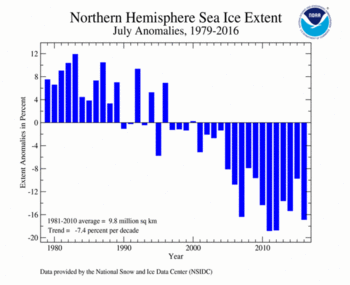Sea Ice Extent
| July 2016 | Sea Ice Extent | Anomaly 1991-2020 | Trend per decade | Rank (38 years) | Record | ||||
|---|---|---|---|---|---|---|---|---|---|
| million km² | million mi² | Year(s) | million km² | million mi² | |||||
| Northern Hemisphere | 7.94 | 3.07 | -9.26% | -7.77% | Largest | 36th | 1983 | 10.57 | 4.08 |
| Smallest | 3rd | 2012 | 7.67 | 2.96 | |||||
| Ties: 2007 | |||||||||
| Southern Hemisphere | 16.02 | 6.19 | -0.31% | +1.24% | Largest | 19th | 2014 | 17.11 | 6.61 |
| Smallest | 20th | 1986 | 15.32 | 5.92 | |||||
| Globe | 23.96 | 9.25 | -3.46% | -1.97% | Largest | 36th | 1979 | 26.83 | 10.36 |
| Smallest | 3rd | 2011 | 23.47 | 9.06 | |||||
Data Source: National Snow and Ice Data Center (NSIDC). Period of record: 1979–2016 (38 years)
According to the National Snow and Ice Data Center (NSIDC), the Northern Hemisphere (Arctic) sea ice extent — which is measured from passive microwave instruments onboard NOAA satellites — averaged for July 2016 was 8.13 million square km (3.14 million square miles), 1.65 million square km (640,000 square miles), or 16.87 percent, below the 1981-2010 average. This was the third smallest July Arctic sea ice extent on record, and 190,000 square km (73,000 square miles) larger than the smallest July Arctic sea ice extent that occurred in 2011. This ended a three-month stretch of record low sea ice in the arctic with five of the first seven months of 2016 setting new low monthly Arctic sea ice extent records. For the entire month, the rate of sea ice loss was 83,800 square km (32,400 square miles) per day, which was slower than the average of 86,800 square kilometers (33,500 square miles) per day. Regionally, windy conditions and below-average temperature compacted sea ice in the Laptev Sea which slowed the ice retreat during the month. At the end of July, below-average sea ice was observed in the Kara, Barents, and Beaufort seas with near-average ice coverage in the Laptev and East Siberian Sea. July Arctic sea ice extent is decreasing at an average rate of 7.3 percent per decade.
The July Southern Hemisphere (Antarctic) sea ice extent was 16.50 million square km (6.37 million square miles), which was 30,000 square km (10,000 square miles), or 0.18 percent, above the 1981-2010 average. This was the 19th smallest July Southern Hemisphere sea ice extent on record and the smallest since 2011. The July 2016 Antarctic sea ice extent was in contrast to the sea ice during the previous three Julys, when record and near-record large extents were observed. Sea ice across the Antarctic expanded at a rate faster than average during the first half of the month with near-average ice expansion during the rest of July. Southern Hemisphere July sea ice extent is increasing at an average rate of 1.2 percent per decade, with substantial inter-annual variability.
For further information on the Northern and Southern Hemisphere snow and ice conditions, please visit the NSIDC News page.
 NOAA's National Centers for Environmental Information
NOAA's National Centers for Environmental Information

